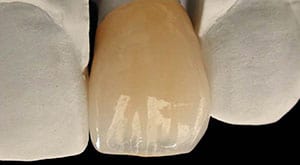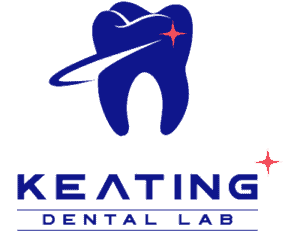KDZ Ultra® Articles
Discussion of Gold vs. Porcelain Dental Crowns vs. Ceramic Crowns
Video Transcript
Today, I’d like to talk to you about the advantages of material we’re very excited about and that is the KDZ Ultra
®. The KDZ Ultra
® is a zirconia oxide coping, almost like a porcelain fused and metal crown, that’s overlaid with beautiful layering ceramic.
Gold Dental Crowns
If we try to compare this with gold, the PFM and the Ultra, gold is tried and true. It’s a very conservative prep but it’s obviously not aesthetic and we even have patients in our practices now that come in and they have beautiful gold restorations and even though they’re clinically acceptable they want them removed because of the aesthetic value. Gold is conservative, time tested but not aesthetic.
Porcelain Fused to Metal Dental Crowns (PFM)
Now we have the porcelain fused and metal crown again time tested but because it has a metal coping or core, which initiates grains into the prep or the final restoration we need to overlay with ceramic. Now if we provide enough room, then this can actually look very, very aesthetic but this is a very aggressive prep. Typically, we’d like to see the ceramic, we’d like to see about 2 mm reduction so they can actually hide the influence of the metal core coping
KDZ Ultra®
This brings us to the KDZ Ultra
®. Again, this is a zirconia core similar to a PFM but is tooth colored and it actually has some translucency and then we overlay with beautiful layering ceramic.
Gold, PFM, KDZ Ultra® Comparison
If we look at the three advantages here. Let’s look at conservation of two structures. Typically with gold we would see a restoration that can be as thin as a millimeter on the occlusal maybe a little bit thinner, and 3 1/4 to a millimeter axial and facial reduction. PFM, 2 mm. A KDZ Ultra
® because of the translucency of the core we can have this to be as thin as a millimeter on the occlusal. A millimeter to a 1 1/2 on the axial wall so it’s a more conservative prep than the PFM not quite as conservative as the gold.
I show you our model here. It’s very cool just to show you the aesthetic value because the KDZ Ultra
® having a relatively translucent coping is zirconia but when it’s only 0.5 mm thick it’s relatively translucent. Having get aesthetics and improved over the PFM. Here we have a PFM on the right side, an Ultra on the left side. These are little LED lights and you see as I turn on the LED light we can see the light transfer from the inside of the Ultra. We don’t see it at all from the PFM and if you go back to your practice, what you are going to see is porcelain dental crowns fused and metal crown that just jump out of you and say “look at me, I’m the fake one” because light cannot penetrate through the restoration and light up that roots so we get that dark shadow where you can see the Ultra looks almost like a natural tooth.
Final Conclusions
If we look at other factors here, let’s look at cusp for the patient or cusp for you as a dentist. What’s the most expensive? Gold. That’s almost expensive restoration comes out at Keating Dental Art. Second, is the porcelain fused and metal crown especially if you use a precious or semi-precious and the least expensive is the KDZ Ultra
®. Now we look at marginal fit, we see a KDZ Ultra
® very close to what we see with the gold crown. Also, because this is translucent we can keep our margins super gingival where obviously with the porcelain fused to metal crown, we typically bury our margin subgingival so we eliminate or inhibit the influence of the metal.
Hopefully, that clears some things out regarding the advantages of our KDZ Ultra
®.
How Ceramic Dental Crowns are Attached/Cemented
Video Transcript
Today I would like to talk to you a bit about the KDZ Ultra
® and what we use to cement them. You know traditionally are all ceramic dental crowns whether be luminous or even Empress and thin emax we have to bond them in the place which requires high technique sensitivity and multiple steps.
KDZ Ultra® Dental Cement Advantages
The advantage of a KDZ Ultra
® how these are fabricated. We have a zirconia coping or core, very very strong and then we overlay with a beautiful powder liquid ceramic and we use Noritake which I think is the most beautiful ceramic we have out there. What we can cement the Ultra because we have the strong core we can almost use anything we want. The best way to bond any crown or any restoration to a tooth is via adhesion and adhesive cementation that would require a dentin bonding agent and a true resin dental cement. Often times we can’t maybe just like a molar or sub gingival margins, patient has a big tongue we can’t put a rubber dam to go through all those isolation steps or the steps during isolation would be prohibitive.
Easy to Use
The nice thing about the Ultra because we have the strength we can cement it with anything we want. The best is always a total edge and a resin cement. The second are the self etching resin cements. Very easy to use. It’s a little bit of compromised on bond to tooth and the restoration but as long as we have a relatively retentive prep design this is a restoration that will stay on for many, many years. Very easy to use.
Temporary Cement Restorations
Lastly, the very cool thing about the Ultra because the strength of the core we can even temporarily cement this restorations. We certainly couldn’t do that with Empress, with a luminous crowns or even thin e.max and were that make be advantageous is the situation when the patient comes and the tooth is very very sensitive let’s say to hot and cold and you think maybe it’s a cracked amalgam that was there previously. You go ahead and prepare the tooth for a crown, you put a temporary and the tooth is still sensitive. We’ve all gone in thinking it was the provisional that causes sensitivity so we go ahead and cement the definitive crown only to have the ended ons so maybe ourselves drill a little hole to the top of that beautiful crown, do the end-on and fill the access opening.
Ceramic Restoration and Final Conclusions
The nice thing about the Ultra when I have a situation where the tooth is hot or sensitive during that entire provisional phase, I can temporarily cement it. Ultra is one of the few of the all ceramic restoration we can do that with. I can temporarily cement that, see if that calms down and then I can have the patient back and typically wait about 60 days two months. If that calms down I pop it off and bond into place. If however it goes to an ended on situation the ended ons can pop that crown off, go ahead and do the endo, maintain the same margins then when the ended ons is done, I can bond this crown into place. I hope that it helps and gives you the advantages of using an Ultra as compared to some of the other weaker ceramic systems that are available in the dental market.
Discussion of the different materials used, why one better than the other, Layering of Ultra Products
Video Transcript with Dr. Hornbrook
Here at Keating Dental Lab we do a lot of the KDZ Ultra
®. The KDZ Ultra
® is zirconia coping, just like a PFM would be, a metal coping overlaid with beautiful powder liquid ceramic and we use Noritake.
Ultra vs. Monolithic Zirconia
A huge advantage of the Ultra versus just a monolithic zirconia is the depth of color especially if you work on the anterior or say an anterior crown, an anterior bridge. I consider premolars anterior teeth so back to premolars we get the advantage of a well fitting material and strong material and zirconia. Relatively translucent at least tooth colored as a core and then all this beautiful overlying ceramic.
Anterior Crowns
The way the lab fabricates this is we go ahead and mill the zirconia coping though we have a lot of options here. Let’s say it’s a mandibular molar or even a premolar where you look in the patient’s mouth and you see the entire crown or the patient has a wide opening and you see the crown you want optimal aesthetics, the lab overlays the entire zirconia coping with the Noritake, the powder liquid ceramics so we have optimal aesthetics because of potential depth of color. The ceramics will put dentin and enamel and translucent layers to maximize the aesthetics. That’s how typically do anterior crowns.
Posterior Crowns
For situations in the posterior, we have some other options here. Let’s say this is for a smaller mandibular first molar where the patient doesn’t show much of the occlusal or they have limited vertical opening but we still on a nice aesthetics from the facial or they’re not going to wear their nocturnal appliance may break all their teeth we can actually design this so that what the lab does is they mill this coping so that it is milled to full contour on the occlusal surface and then they can overlay just the buccal cusp.
Advantages
The advantage of this, this zirconia has a flexural strength of about 1500 mega pascals where the overlay has a flexural strength of about 100 which is similar what we see with the porcelain fused and metal crown. We can design this almost anyway we want. Especially in maxillary molars what I do a lot because I like the aesthetics of a layered that we see in the Ultra so what all the lab do is they will mill the coping so it’s full contour on the occlusal and my functional cusp, this would be my palatal side.
My functional cusp undergoing the most amount of stress, and then I’ll have overlay, the aesthetics zone. This is a nonfunctional cusp. They can overlay this so this would be the buckle. With all this beautiful ceramics and we have some amazing technicians. So I get the best of both worlds. I can have optimal aesthetics. I have a relatively translucent core in the zirconia. I have very accurate margins with the zirconia. I have a material that 10 to 15 times stronger than the porcelain fused and metal crown with the ceramic portion on a functional cusp. This can be very conservative. The thickness here I can have as little as 0.5 mm occlusal reduction.
Final Conclusions
Hopefully, that clears up some of the misconceptions of why would want to do an Ultra versus a traditional Bruxer and certainly the advantages of a zirconia supporter restoration like the KDZ Bruxer over a porcelain fused and metal crown.
Benefits to KDZ Ultra® Ceramic Crowns and Bridges
Video Transcript
The KDZ Ultra
® is a very popular restoration here at Keating Dental Lab. What are the advantages of the Ultra. We really have the best of both worlds. We have the strength of zirconia and then we the ability to overlay with beautiful powder liquid ceramic so we get the depth that we frequently saw with the PFM. A lot of our monolithic zirconia most of our color comes from superficial staining. Where the Ultra we overlay on top of it. That’s one of the biggest advantages. When I want to maximize strength and maximize aesthetics the KDZ Ultra
® is a restoration of choice.
Best Ways to use the All ceramic Crowns/Bridges
Video Transcript
When I think about when I would use a KDZ Ultra
® and that’s a zirconia core or coping overlay with powder liquid ceramic. I think about when I would use those one is anterior bridges that are greater than 3 units. We certainly can’t use lithium disilicate or even our high translucency zirconia.
Anterior Bridges
When I do anterior bridges, I like to use the Ultra. I will eliminate metal almost completely in my practice. When we look at zirconia basically that’s a substitute for metal. Let’s say I have six unit bridge from tooth number 6 to tooth number 11. I need a strong core but I want it to look good, it’s part of the aesthetics zone. I will use the zirconia in the Ultra as my core. We did a cross section let’s say the central. That would the cross section. This would be the connector to the next central. I want the strength of the zirconia so let’s say this would be the core on a full coverage crown. Then I want to overlay with a beautiful layered material to optimize aesthetics.
Anterior Bridge Advantages
The advantages of depth through the powder liquid where the ceramic going to put dentin, enamel, translucent opalescent ceramics overlaid on a core then I say about this core versus the PFM. This is tooth colored or dentin shaded. It’s usually about 0.5 mm thick. So now when light penetrates through all these beautiful layers the ceramics put in and it hits the zirconia, the zirconia acts like dentin and so we get refraction and reflection of light back to that ceramic. Far superior aesthetics in my opinion than porcelain fused and metal crown. I like it for anterior bridges.
Posterior Bridges
I like it for multi unit posteriors. The anterior bridges would be over three units because if three units or less I can either use e.max lithium disilicate or I can use bruxer HT or bruxer aesthetics high translucency. Greater than 3 units in the anterior and all my posterior bridges would be Ultra because I like the powder liquid layer on top of the that.
Single Crowns
Next would be situations where I would have single crowns in the posterior where I want to optimize strength and aesthetics. Then I see this do a lot of times on maxillary molars where the zirconia is milled to full contour on a functional cusp. This would be our parallel cusp which is functional but now on the buccal where I want optimal aesthetics, the ceramist can overlay this aesthetic area which is nonfunctional. I get all this beautiful depth of color from the powder liquid and then I get this optimal strength on the functional cusp because the flexural strength of a zirconia is 1500 mega pascals. I cannot break that. Where the overlaid powder liquid just like we see with the PFM is 100.
Single Crown Advantages
The advantage of this is the patient’s beaten up on this functional cusp on the marginal ridge in a material that are not going to break and then we have the beauty of the overlaying ceramic on top of that zirconia. Best of both worlds.
Final Conclusions
Anterior bridges greater than 3 units. All my posterior bridges and single crowns primarily molars, some premolars on the patient what I call destroyers that beat up everything then I like this a little stronger on functional cusp. Hope that clarifies when I would use a KDZ Ultra
® as compared to other restorative materials.






